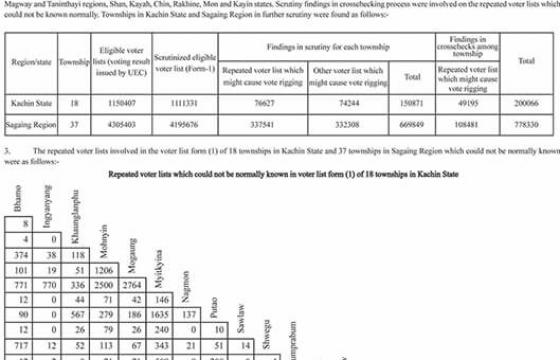One controversial and visible challenge coming out of the recently finished 21st Century Panglong Conference (21CPC) is the demand for the status of new national state and this has created a big headache for the power-holders of Nay Pyi Taw and as well, for the Shan – the majority non-Bamar ethnic population who called themselves “Tai” – political and armed groups, on how to handle and tackle this delicate and sensitive issue.
The emotionally charged proposal was the demand for self-rule and autonomous states by several ethnic sub-group or minorities, particularly in Shan State.
The ethnic groups that demanded their own self-administered states include: the United Wa State Army (UWSA), arguably Burma’s strongest ethnic armed group, which does at present fall within a self-administered division; the Ta’ang (Palaung) National Liberation Army (TNLA); the Pa-oh; and Tai Leng group. Meanwhile, the National Democratic Alliance Army (NDAA) based in Mong La demanded a self-administered zone for ethnic Akha people.
Danu, Kokang, Pa-Oh, Palaung self-administerd zones and Wa self-administered division are in Shan State; only Naga self-administered zone is within the Sagaing Region.
The Shan were already feeling the pinch when almost all self-administered zones and a division were carved out of Shan State and now the Wa, Pa-Oh and Palaung are demanding national-level state status, which literally would mean the loss of territories for the majority Shan population. And to exacerbate the problem, UWSA and TNLA were demanding more territories than have been demarcated by the existing present, political country map.
UWSA moved down to south of Shan State with its hundreds of Wa population, during the late eighties to fight with the Shan Mong Tai Army (MTA) of Khun Sa, on the side of the Burma Army, and have never returned back ever since. And now the Wa wanted to claim the territories that are normally inhabited by the Shan.
The Wa were said to be given verbal promises that if it could drive out the MTA, the conquered territories would be allotted to them, by the then military intelligence chief General Khin Nyunt. However, the new military regime that followed didn’t honour the verbal promises of Khin Nyunt and started to demand the Wa to move back to their original stomping ground in the north, close to the Chinese border, but refused and have been at odds with the military and government ever since.
The same is also true with the TNLA claims of more territories to be incorporated into its demanded state-level administration, when it troops expanded into the majority Shan settlement, which incites animosity among the two ethnic groups, which have for immemorial time lived harmoniously together.
Since last year, shortly after the signing of Nationwide Ceasefire Agreement (NCA), the signatory Restoration Council of Shan State/Shan State Army (RCSS/SSA) went up to the northern part of Shan State to reinforce its troops (at the military base along the Chinese border in Namkham township) and reportedly also to defend the Shan population from the TNLA riding roughshod on the population. The armed conflict between the RCSS and TNLA ensued, resulting in huge exodus and producing thousands of refugees until today, with no end in sight.
The UWSA in its position paper tabled at the 21CPC also reveal some of its thinking, regarding this issue. The paper said that the present establishment of administrative region procedure gives more rights to the larger ethnic population and could even decide the fate of the lesser minority groups, which is not in line with the notion of national equality. Thus it suggested that if an ethnic group is 100,000 living in the same region, it could apply for autonomous region; if 200,000 autonomous prefecture/district; and if 300,000 a national-level state.
But regardless of such enthusiastically thought out inputs, according to Maj. Sai Nguen, the spokesperson for the RCSS/SSA, said that it is every ethnic group’s right to make such a request. However, he said that these matters are directly concerned with the central government, and therefore fall under the 2008 constitution.
He explained that several stages must be met in order to form an autonomous state.
Gen. Hso Ten, a veteran of the Shan State Progress Party/Shan State Army (SSPP/SSA), said that in order to establish a new state, a detailed process must be followed.
“It does not depend on us [SSPP/SSA],” he said. “It needs to pass through parliament and the Shan State people. It is not so easy just to establish a new state.”
He added that such a new state would have to depend on ethnic population, as well as language and literature, which should be historically sound and traceable.
“It’s their [ethnic minorities’] right and we cannot stop that,” said Khuensai, the director of the Pyidaungsu Institute for Peace and Dialogue.
Khuensai continued: “What we have to consider is the loss we are facing as the majority group.
“But whatever we lose, they will also lose. We all faced with losses.”
Still another input that has been making the round, since the demand of the ethnic sub-groups or minorities become louder, especially in Shan State, is that invoking the “Federated Shan States” structure of 1922, where some 30 or so administrative states were diversified, each with its traditional ruler, called Saohpa. Of course, the Federated States would be led by democratically elected people’s representatives, rather than the traditional rulers.
Accordingly, the political system of Federated Shan States, made use of in pre-War days were said to be satisfactory, for the Wa, Pa-Oh, Palaung, Danu and the likes were ruled by their own traditional rulers and not by anyone else.
One couldn’t agree more, when Khuensai said: “What we have to do now is establish equal rights. And the best way to do that is to sit together and discuss the issues until we have solutions.”
Whatever it is, since the ethnic upsurge and identity consciousness are international trend, they are to be encouraged. The decentralization and devolution of power to address the demand should also be done sequentially in a row. And this is none other than going through the existing administrative procedure, with a lot of democratically charged discussions to determine a set of criteria that all could live with, on how different level of administrative zone, division and up to national-level state administration could be meted out.
It is hoped that cooler heads would prevail and this seemingly hard to crack nut could be overcome through mutual understanding and benefit.






